Algae are a common part of natural water bodies and a common occurrence in aquariums. They are also thought to oxygenate the atmosphere. But do they oxygenate water?
Algae supplies dissolved oxygen in the water for fish, and other aquatic animals to consume. They produce and release oxygen into the water and the atmosphere as a by-product of their photosynthesis during the day.
That is the short answer. Read on to learn how algae oxygenate the water, consume oxygen, and discover other interesting information about algae.

Table of Contents
Does Algae Oxygenate Water?
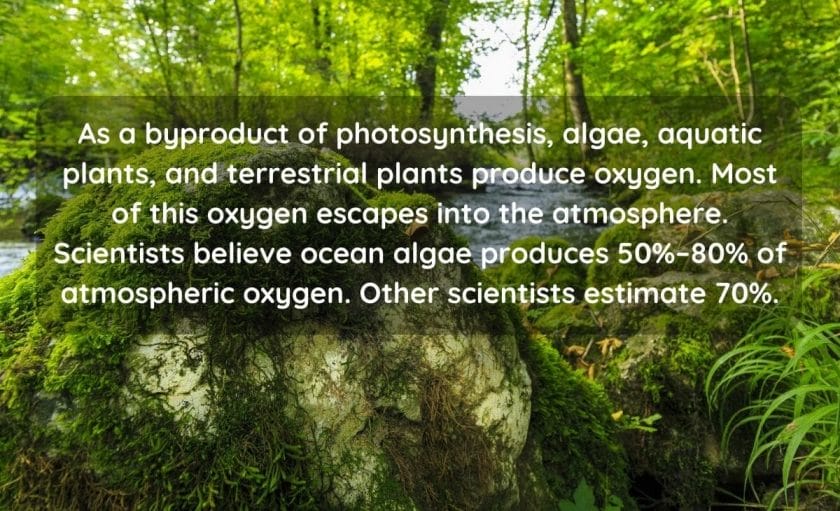
Algae, aquatic plants, and terrestrial plants produce oxygen as a by-product of photosynthesis. But a great bulk of this oxygen is released into the atmosphere.
Some scientists estimate that ocean algae is responsible for about 50%-80% of the oxygen in the atmosphere. Other scientists leave the estimate at 70%.
However, oxygen production in water is an involuntary, but inevitable result of algae photosynthesis.
Algae usually absorb water and carbon dioxide in the presence of sunlight during photosynthesis.
The water loses its electrons as it is oxidized, but the carbon dioxide gains electrons as it is reduced. This loss and gain of electrons transform the water into oxygen and the carbon dioxide into glucose.
The algae release oxygen but store the energy within its glucose molecules as a food source. Terrestrial plants also access and store energy in the same way.
Algae use chlorophyll during photosynthesis. Chlorophyll is the green pigment in plants. It is a light-absorbing pigment within the algae cells that helps with photosynthesis.
It absorbs energy from blue and red light waves. But it reflects green light waves, which is why most algae appear greenish.
All algae species possess chlorophyll.
However, some species have distinct photosynthetic pigments that conceal the green pigment. This is why other algae species appear to have different colors other than green.
Does Brown Algae Produce Oxygen?
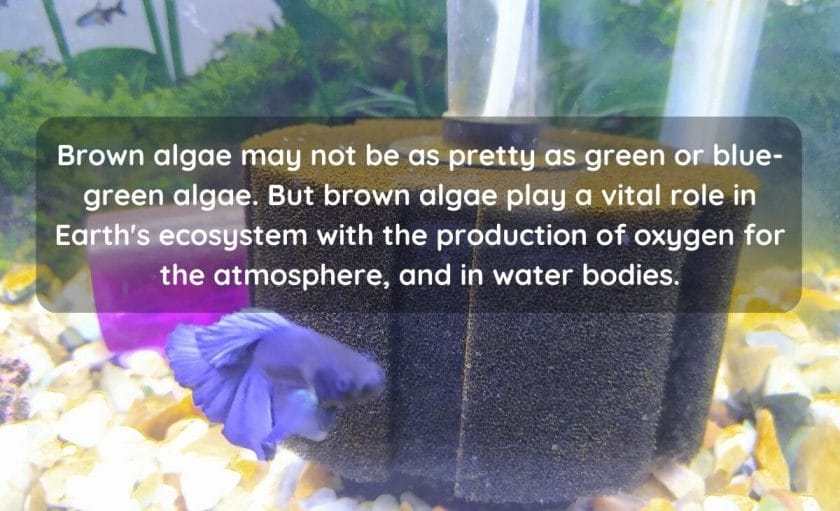
Brown algae are also known as diatoms. In the aquarium hobby, they normally appear in aquariums during the cycling stage, as you rarely find brown algae in a mature tank.
But do they produce oxygen?
Since they are brown, they have developed an exceptional set of pigments that soak up light for photosynthesis even when the amount of light is insufficient.
Their brown color, which is a result of their special pigment, allows them to photosynthesize more than green algae.
This is because they can absorb light for photosynthesis in a dimly lit environment; which is something green algae cannot do well.
The special pigments and biochemical structures that brown algae use to photosynthesize in dark conditions remain a puzzle to scientists today. They are yet to unravel its workings.
Brown algae may not be as pretty as green or blue-green algae. But brown algae play a vital role in Earth’s ecosystem with the production of oxygen for the atmosphere, and in water bodies.
Does Green Algae Produce Oxygen?

Green algae are also another type of excellent oxygen-producing algae. They oxygenate water bodies and also release oxygen into the atmosphere.
Green algae generally refer to two types of algae; charophytes, and chlorophytes. These two types of green algae have pigments that are majorly green. This is why they are called green algae.
You can find chlorophytes in saltwater bodies. But the charophytes are endemic to freshwater bodies. However, they produce and release oxygen into the water and the air wherever they are found.
Does Blue-Green Algae Produce Oxygen?
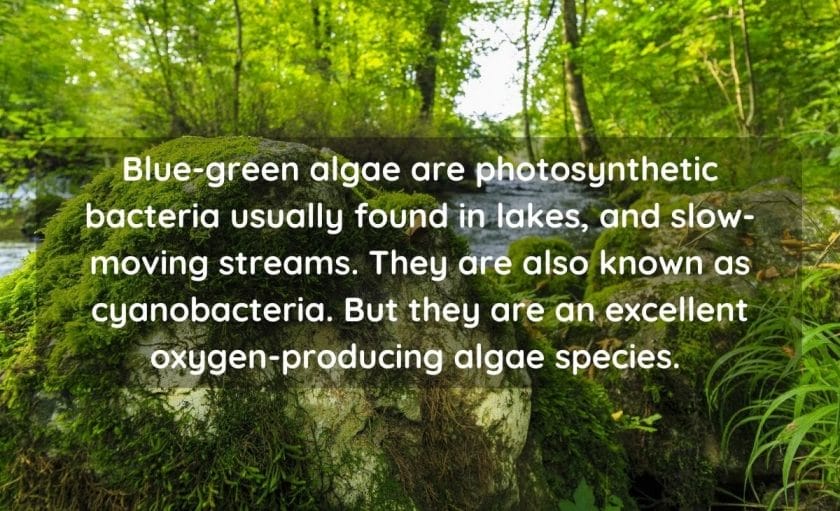
Blue-green algae are photosynthetic bacteria usually found in lakes, and slow-moving streams. They are also known as cyanobacteria. But they are an excellent oxygen-producing algae species.
Spikes in phosphorus and nitrogen levels usually fuel their growth.
Blue-green algae are one of the oldest known oxygen-producing algae on Earth.
The oldest Blue-green algae used forms of chlorophyll, and pigments such as carotenoids, and phycobilins to take the energy from the light for photosynthesis.
The oxygen they produce during photosynthesis is released into the water and the atmosphere.
Does Algae Produce Oxygen in Aquariums?
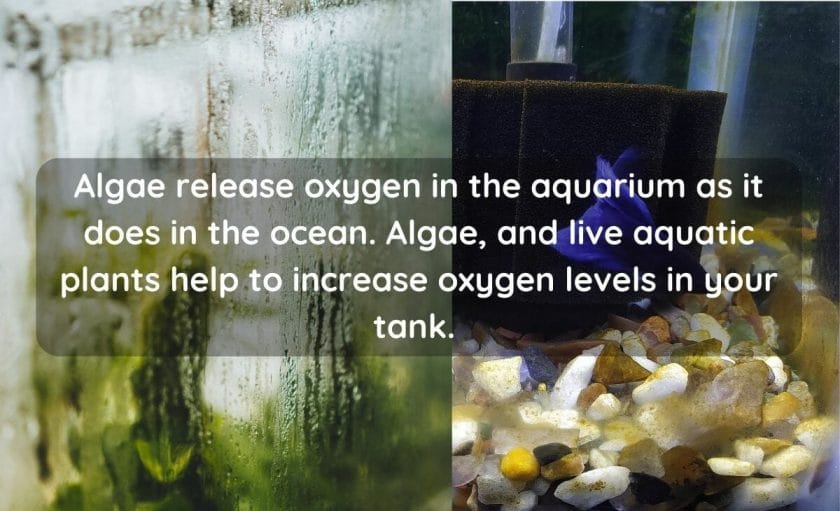
Algae release oxygen in the aquarium as it does in the ocean. Algae, and live aquatic plants help to increase oxygen levels in your tank.
However, oxygen levels in your aquarium can be depleted if you fail to control the algae growth.
During the day, algae produce oxygen as a result of photosynthesis.
But during the night, algae reduce oxygen levels as they switch from photosynthesis to a process of respiration where they consume oxygen.
Oxygen depletion in the water due to nightly respiration can make oxygen levels fall so low that it threatens your aquarium fish. This is especially true when you have algae blooming in your tank.
Hence, many aquarists prefer to reduce algae growth, and bloom in the tank by using live plants to starve algae of nutrients for growth.
Does Pond Algae Produce Oxygen?

The main oxygen sources for ponds are oxygen from the air, and oxygen from aquatic plants, and algae in the water.
Fish come to the top of the pond occasionally. That is because there is contact between the top of the pond, and the atmosphere. Hence, they get more oxygen closer to the top.
The other significant sources are the aquatic plants and algae in the pond.
Algae blooms in ponds can affect how much oxygen is produced in the pond. Pond algae typically produce oxygen from photosynthesis.
They release oxygen into the pond and the atmosphere.
One of the main sources of oxygen in many ponds is microalgae, also known as phytoplankton.
This microscopic plant releases oxygen into the pond water as it undergoes photosynthesis during the day.
However, pond algae remove oxygen from the water for respiration at night and on cloudy days when the light is insufficient.
But the amount of oxygen the algae consume is usually less than the amount produced during the day.
Does Algae Produce Oxygen At Night?

Algae produce oxygen during the day because they use sunlight for photosynthesis.
Remember that photosynthesis is the process that makes algae release oxygen into the water.
However, in the absence of light, algae generally do not produce oxygen. Hence, no oxygen is produced in the water at night.
This means that continuous respiration by fish, algae, and other aquatic life in the water depletes the oxygen in the water at night.
Does Algae Use Oxygen or Carbon Dioxide?
Algae photosynthesize in the presence of carbon dioxide, water, and light. So for photosynthesis, algae use carbon dioxide, not oxygen. Oxygen is passed out as a by-product of carbon dioxide.
However, at night, when algae switch from photosynthesis to respiration, algae use oxygen. Algae cells absorb oxygen to put out carbon dioxide during the process of respiration.
Therefore, while algae use carbon dioxide during the day to produce oxygen as they photosynthesize, they consume oxygen at night when they switch to respiration.
But the amount of oxygen algae consume at night is usually less than the amount produced and released during the day.
How Does Algae Consume Oxygen in an Aquarium?
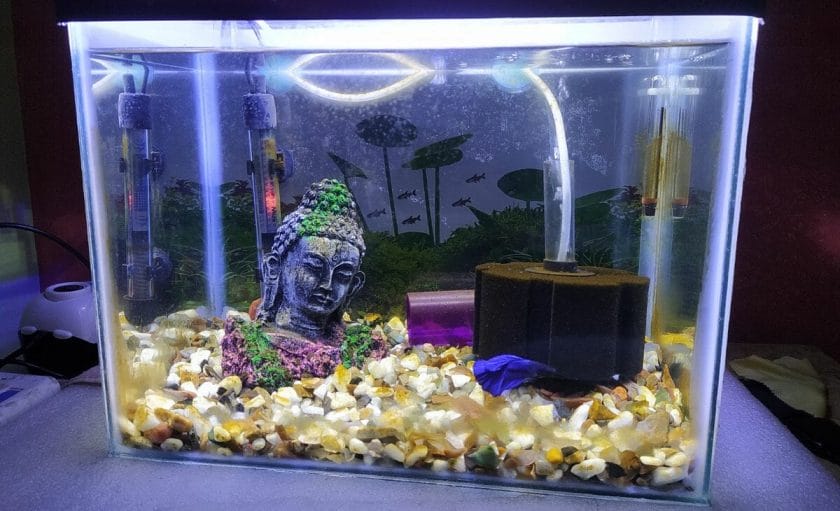
There are two ways that algae consume oxygen in an aquarium.
When algae grow in the tank, you normally get more oxygen. But algae consume oxygen at night, which can often be problematic when they grow too much.
Algae’s oxygen production is caused by the presence of light, and carbon dioxide in the atmosphere. These are the main factors that spur photosynthesis in algae.
But at night, there is no light. So algae cannot photosynthesize.
This is why algae switch at night from photosynthesis to respiration, which is a process that requires algae to consume oxygen.
This is the first way that algae consume oxygen in aquariums.
Ordinarily, if you have aquarium algae under control, algae will usually not consume more oxygen than was released during the day. So the consumption of oxygen, when algae growth is controlled, is usually not a problem.
But when you have too much algae in the tank, such as an algae bloom, your aquarium is at risk of a major drop in oxygen levels.
When the nutrients spurring algae growth are exhausted, all the algae or some of it will die off. This is especially worse when the die-offs occur after an algae bloom.
What usually follows the die-offs is an increase in bacterial activity to decompose the dead algae.
This increase in bacterial activity causes a major drop in oxygen levels.
This is the second way that algae consume oxygen.
So if you have algae in your aquarium, you want to do your best to keep it under control. Perform a regular water change, do not overfeed, and ensure that you take out uneaten food from the aquarium after feeding.
You also want to test the water parameters regularly to ensure that you keep it under control.
Does Algae Produce More Oxygen Than Trees?
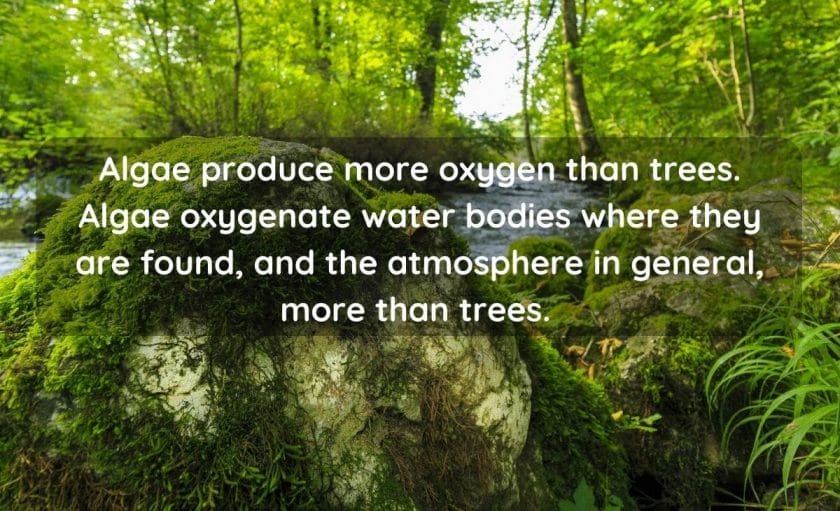
There is no doubt that algae produce more oxygen than trees. Algae oxygenate water bodies where they are found, and the atmosphere in general, more than trees.
Algae are responsible for more than 70% of the oxygen in the atmosphere. But trees, on the other hand, are only responsible for about 28% of the oxygen in the atmosphere.
The ocean covers some 71% of Earth’s surface, and is believed to be the source of more than half of the oxygen available on the planet.
Prochlorococcus is one of the smallest species capable of photosynthesis on Earth but produces up to 20% of the oxygen in the biosphere.
This 20% is almost higher than the amount of oxygen produced by all the trees, and tropical rainforests on all of Earth’s land surfaces.
Conversely, trees pale in comparison, as they produce only about 1/3rd, some 28% of Earth’s oxygen.
That figure pales in comparison to the total amount of oxygen produced by algae in the ocean.
However, this is not to say that trees do not produce enough oxygen to be recognized as a crucial part of our ecosystem.
Trees produce oxygen when they photosynthesize, but the amount is nowhere close to how much oxygen algae produce.
Also, if the question was whether algae oxygenate water more than trees, the answer would be a resounding yes.
Algae supply more oxygen to the water than trees. More than that, algae supply oxygen directly to the water, better than trees since they mostly thrive above and inside the water.
Which Algae Produces the Most Oxygen?
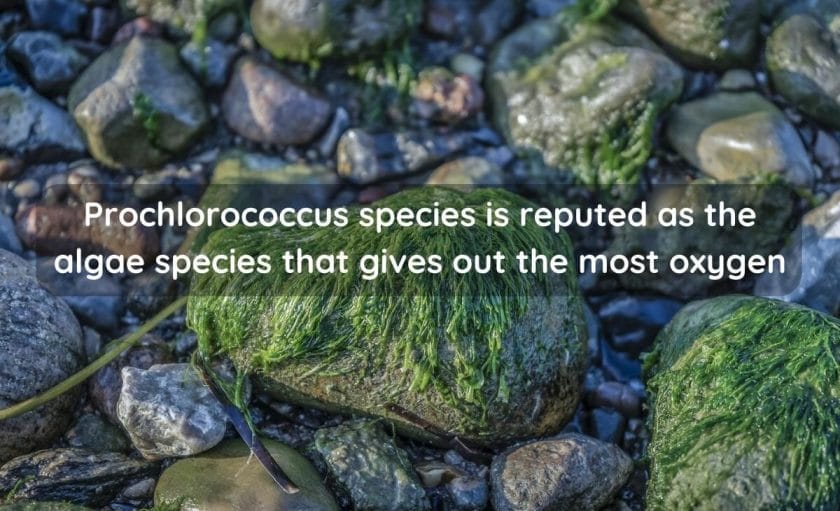
There are thousands of oxygen-producing algae species, but the Prochlorococcus species is reputed as the algae species that gives out the most oxygen.
It is the smallest photosynthetic organism on Earth. But it is largely responsible for oxygenating the ocean.
FAQ
Does Algae Grow Better in Low or High pH?
Algae growth does not necessarily depend on pH. The availability of carbon dioxide, sunlight, and nutrients in the water determines algae growth.
Of the more than 30,000 algae species on Earth, some thrive in high pH environments while others in low pH environments.
Is Algae Bad for the Aquarium?
While algae are not bad, you want to control algae growth in your aquarium. There is no such thing as a 100% algae-free aquarium.
Many algae species give your tank a natural look, aid filtration, supply oxygen, and provide food for your fish. The important thing is to control the growth.
What Causes Low Pond Oxygen Levels
High water temperature and algae usually cause low pond oxygen levels.
The level of dissolved oxygen drops as water temperature increases during the day. Algae respiration at night also depletes pond oxygen levels. The degree of depletion is more when you have an algae bloom.
Conclusion
While algae are responsible for releasing the largest amount of oxygen into the atmosphere, they are also responsible for releasing oxygen into water bodies where it is found.
Algae in your pond or aquarium increases dissolved oxygen levels. But, as pointed out above, you want to keep it under control.
Failing to control algae growth can lead to the undesirable consequences discussed above.
As described above, understanding how pond algae work can help you increase the dissolved oxygen level in your pond or aquarium. It can also help you know when to act when algae threaten to deplete your pond’s oxygen level.
The points in this article will also help you understand how algae work, where to draw the line, and what to expect when you find dead algae in your aquarium.